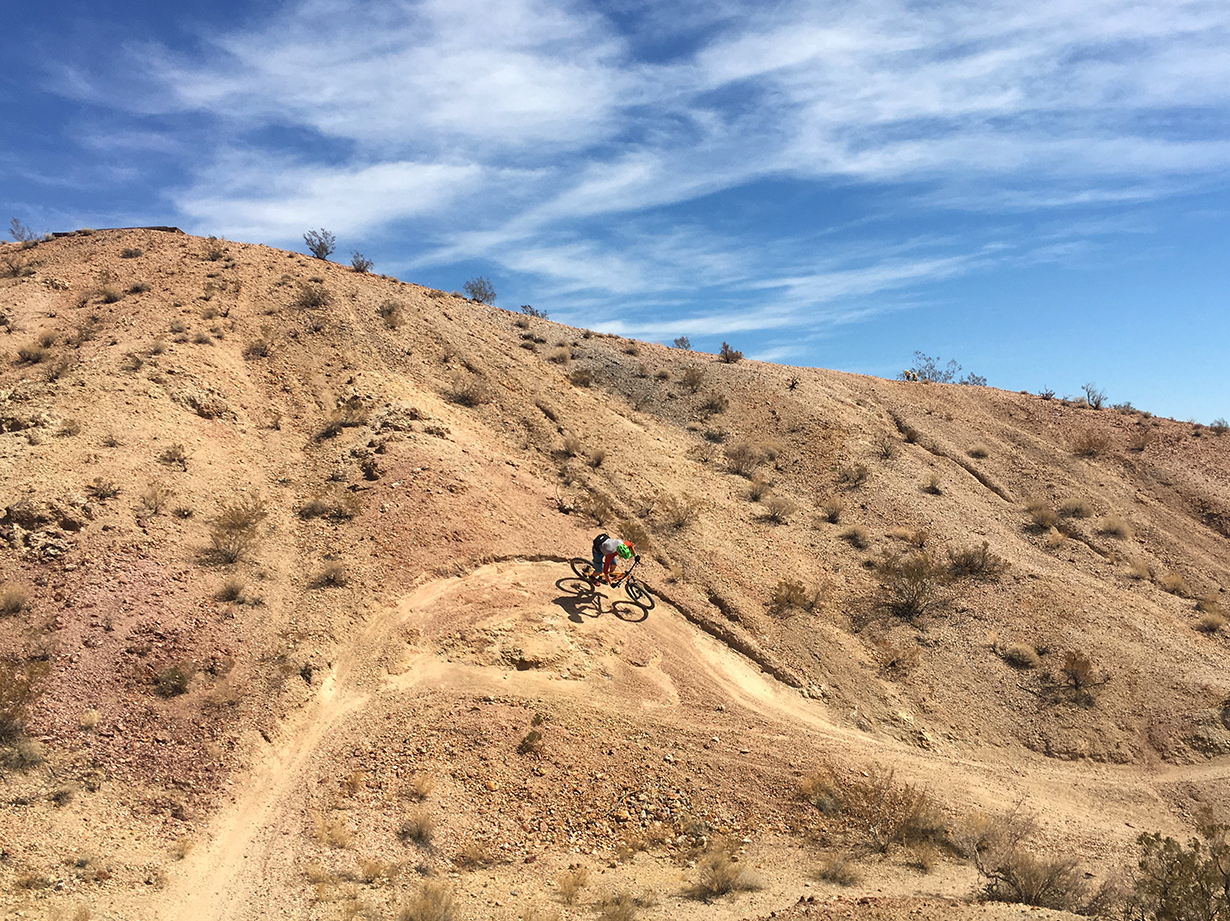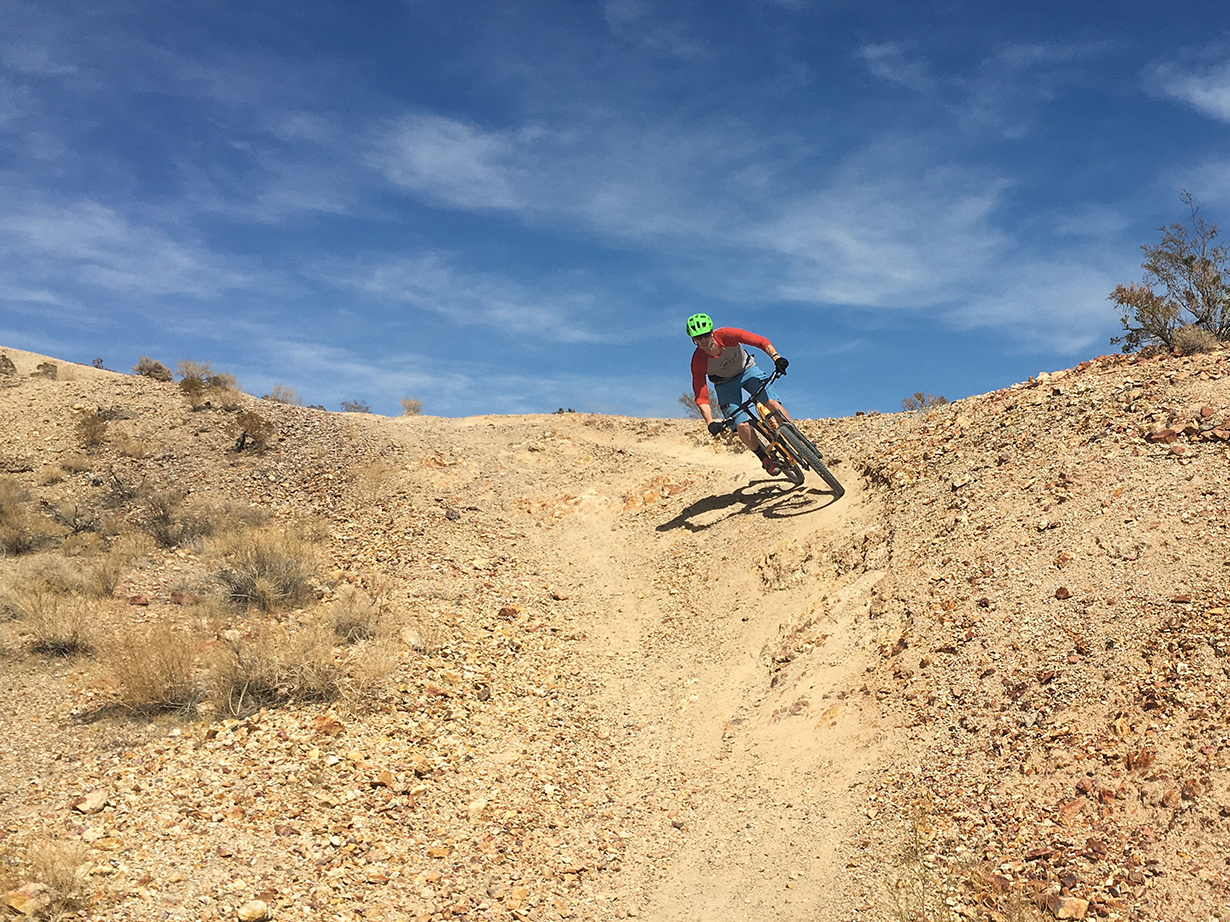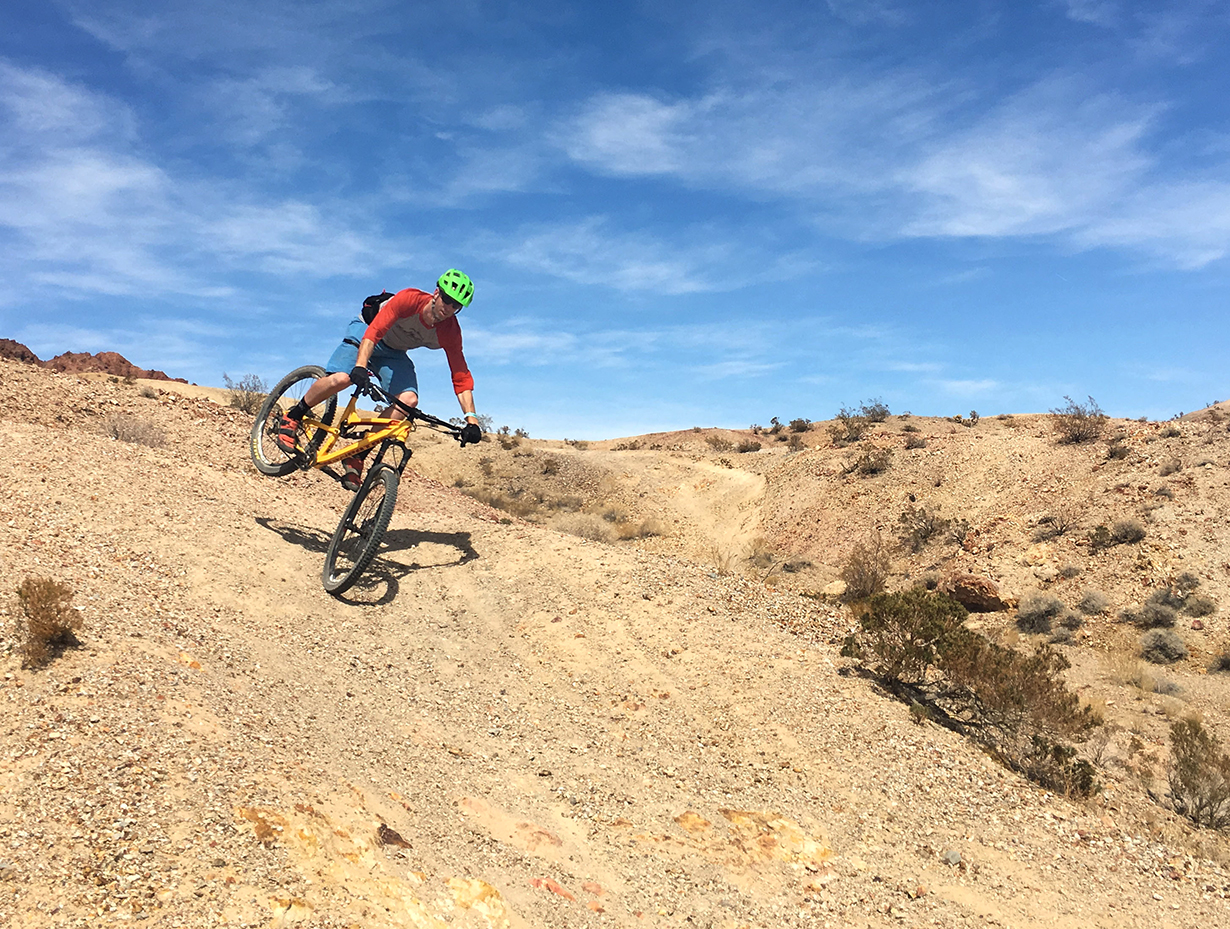2018 Patrol 672
Size Tested: Large
Build Overview:
- Drivetrain: Shimano SLX
- Brakes: Shimano SLX
- Fork: Rockshox Yari
- Rear Shock: Rockshox Monarch RL
Wheels: 27.5′′
Travel: 160 mm rear / 160 mm front
Blister’s Measured Weight: 32.1 lbs (14.56 kg) without pedals
Reviewer: 5’9”, 155 lbs.
Test Location: Boulder City, Nevada
MSRP: $2,900.00

Caveat
Interbike’s Outdoor Demo is located at Bootleg Canyon, in Boulder City, Nevada, which is a little bastion of awesomeness about 25 minutes from the Vegas strip. There’s a mix of fast & flowy and legitimately techy terrain that makes for a pretty decent venue for a demo.
Normally, Blister tries to get as much time on a bike as possible so that we have time to play around with setup, get comfortable with the fit, and hopefully reveal any durability issues that might arise. So for obvious reasons, spending an hour or so on a bike at Interbike’s Outdoor Demo doesn’t give us the time to give a bike our usual treatment.
That said, there’s a lot of value in riding a bunch of different bikes back-to-back on the same trails. Traits that might not be obvious when the bikes are ridden weeks or months apart become evident.
So in other words, back-to-back comparisons on great trails are useful, but don’t take this as the final word on these bikes — especially when it comes to maintenance and durability issues.
So with all that in mind, let’s take a look at the Patrol 672.
Intro
Let’s get one thing cleared up right away: this isn’t a Transition Patrol; Transition has nothing to do with this bike. Patrol is a company out of Indonesia that’s pushing into North America this year, and they have some fairly affordable options. In theory, Patrol could be a contender against other bang-for-your-buck, direct-to-consumer companies like YT.
I spent a bit of time on the Patrol 672, which is their lower-end model of their enduro-oriented 6 series (the higher-end being the $4,399 671). So is the 672 going to put all those other higher-end, more expensive enduro bike manufacturers out of business? I, for one, wouldn’t be holding my breath.
The Build
The 672 is a budget-oriented bike, and Patrol makes a few solid choices in the build kit. Namely, a Shimano SLX drivetrain and SLX brakes, which are probably the best values on the market — they work well and they’re eminently affordable.
Similarly, a Rockshox Yari up front offering 160 mm travel stays true to the bike’s enduro-ish intentions and offers most of the performance of a Lyrik at a much more reasonable price. Out back, a Monarch RL is perhaps a bit undergunned on a longer-travel bike like this, but it’s not, in and of itself, a bad unit. That said, the tune on the Monarch RL felt way out of whack on the 672 I rode — more on that below.

While it’s unclear if they’ll be part of the production spec, the SunRingle Inferno 31 wheels equipped with Maxxis Highroller II tires are a solid choice. There’s some indication that production models will get a less expensive Novatec wheelset, but at least on the bike I rode, the Inferno wheels were stiff, and the Highroller II tires are some of my favorite tires of all time.
The one spot where things go significantly awry on the build kit is the seatpost — there’s no dropper post. I can’t remember the last time I rode a 160 mm travel bike that didn’t have a dropper post, and as far as I’m concerned, that’s mandatory equipment on a bike like this. It’d be better to pay a bit extra for it on a stock build than a lot extra for it as an aftermarket add-on. And to add insult to injury, there isn’t even a quick release seat collar — having to pull a tool out at the top of every descent is really annoying. Yes, I’m a delicate snowflake that’s forgotten how to descend with a raised seat.
Fit and Geometry
Patrol hasn’t published the geometry numbers for the 672 yet, but judging by the numbers for the 671, it appears that these bikes were designed in 2012. As bikes have gotten longer, lower, and slacker over the past five years, the Patrol 672 is a throwback to an age of shorter, taller, and steeper bikes.
With a reach of 426 mm and a top tube length of 605 mm, the Large Patrol 672 I rode is more or less in line with most companies’ size Medium bikes. And the 67.5° head tube angle is about 2.5° steeper than most other bikes that are comparable to the 672 in terms of travel.

An argument can certainly be made that modern enduro bikes are too slack and too long to work well on tighter trails where the stability afforded by that geometry is unnecessary. But I think that going as short and as steep as the 672 does is quite a bit too far in the wrong direction. Using the head angle as an example, the 672’s head angle is closer to the bike that won the XC World Championship (Nino Schurter’s Scott Spark RC) than it is to the bike that won the Enduro World Series Overall (Sam Hill’s Nukeproof Mega).
So I’d generally say that anyone looking at the 672 should consider sizing up unless you’re decidedly in favor of the shorter geometry numbers of yore. At 5’9”, I fit comfortably on a Large, and even the Extra-Large 672 wouldn’t be out of line for someone just a little taller than me.
The Ride
The 672 is built around a pretty straightforward horst link suspension design that’s been used by a variety of companies (most notably, Specialized with their FSR link) for a long, long time. Despite the ubiquity of this design and a long history of bikes using this design to good effect, Patrol seems to have missed the mark.
The 672 isn’t an overly efficient pedaler, but it could be considered at the bad end of average for an enduro-oriented bike. And usually that means sacrifices were made to the bike’s efficiency in the name of improving other suspension characteristics in order to make the bike descend better. And for an enduro bike, that’s not necessarily a bad thing.
The problem with the 672 is that it’s not particularly efficient, and the suspension is also fairly terrible. It’s not supple over small bumps and didn’t do a very good job of maintaining traction in corners. But it also used more of it’s travel than seemed necessary on mid sized bumps, which meant it felt a bit wallowy when pressed into corners. The terrain at Bootleg Canyon is quite rocky, and the 672 noticeably hung up on rocks that other bikes (including some with substantially less travel) breezed over without issue.

The only aspect of the 672’s rear suspension that seemed to work well was a decent ramp up at the end that handled bigger hits fairly gracefully.
Now, at least some of this seems to be the result of the bike running the wrong shock tune — it seemed like too much low-speed compression, and a weird transition into the high-speed compression circuit. Those aren’t inherent problems with the Monarch — it’s just a matter of correctly tuning the shock to the frame. I don’t know if the production versions of the 672 will have a different tune, but for the sake of anyone who buys this bike, I hope so.
And then comes the issue of the geometry — by the numbers, the 672 looks short and steep. And one the trail, it feels… short and steep. Bumping up to a large meant that the 672 I rode didn’t feel excessively small, but the head angle is still tied for the steepest I rode at Interbike this year (it’s the same as the 120 mm travel 29er Marin Rift Zone). And that head angle means the Patrol isn’t particularly stable as speeds pick up.
The Yari up front was perhaps the saving grace for this bike, as it worked well (or at least worked as intended). But while the Yari did what it could to salvage the let down that was the rest of the bike, a budget-minded enduro fork can only do so much.
Bottom Line
Bikes are really expensive, and anyone who can make a worthwhile product for less money should be commended. The Patrol 672 costs less money, but it misses out on the “worthwhile product” part of that sentence. The geometry is dated, the suspension is confused, it doesn’t have a dropper post, and it’s kind of heavy.
If the Patrol was the only bike out there at this price point, that’d be one thing. But it’s not — most of the major manufacturers have a bike that competes with the 672 in terms of price, and most of those bikes will substantially outperform the 672 in most other respects.
Most bikes I review these days are pretty good — the reviews are more about highlighting what the bike’s strengths are and figuring out who the ideal buyer for that bike might be. But I’m not sure who the ideal buyer for the Patrol 672 is; it’s shortcomings are significant, and the price isn’t cheap enough to overcome those weaknesses. The best thing I can say for this bike is that hopefully the production version will manage to address these problems, although if all of the 672’s problems were addressed, it’d essentially be an entirely different bike.
